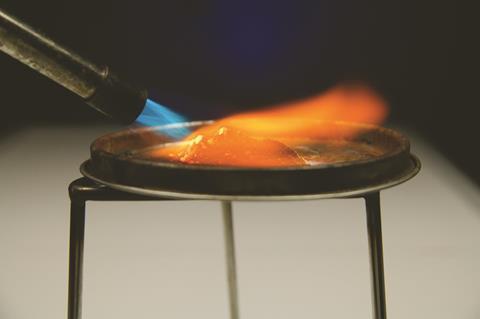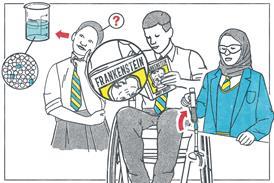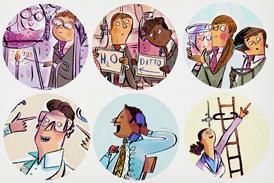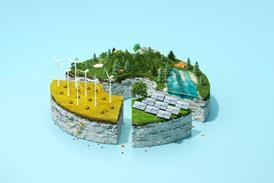Applied science has a key role in the 14-16 curriculum, and its popularity is growing. These 'vocational' science qualifications are no longer the poor relations to general (academic) science qualifications. And chemistry features strongly in them.
-
Courses designed to reflect what real chemists do. Students work individually and in teams, sharing ideas and workload
The numbers of students taking GCSE Applied Science (double award) have grown, from 8916 in 2004, through 18,184 in 2005, to 27,471 in 2006. For the most recent certification, OCR reports that 44 per cent of students taking additional science in the Twenty first century science suite chose the applied option and 56 per cent chose the general option.
One of the attractions of the applied specifications is that courses may be designed to meet the needs of all students, regardless of ability and progression routes. In part, this is because the percentage of internal assessment (Table 1) allows the design of tasks and activities to challenge all students while allowing them to enjoy success. The courses are about science relevant to students' lives and experiences. They emphasise scientific skills and knowledge used by professional scientists, and there is a significant proportion of assessed practical and investigative work.
Table 1: GCSE specifications available from September 2006
| Specifications |
Percentage |
Internal Assessment |
| AQA GCSE Applied Science (double award) | 100 | 65.0 |
| Edexcel BTEC First certificate (=2 GCSEs) | 100 | 100.0 |
| Edexcel BTEC First diploma (=4 GCSEs) | 100 | 100.0 |
| OCR GCSE Applied Science (double award) | 100 | 66.7 |
| OCR Level 2 National Award (=2 GCSEs) | 100 | 100.0 |
| OCR Level 2 National Certificate (=4 GCSEs) | 100 | 100.0 |
| WJEC GCSE Applied Science (double award) | 100 | 66.7 |
| AQA GCSE Science + GCSE Additional Applied | 50 | 42.5 |
| OCR* GCSE Science + GCSE Additional Applied | 50 | 41.7 |
| * Only available through the Twenty first century science suite | ||
Specifications available
Intermediate-level applied science specifications come in three sizes:
- one GCSE or equivalent - GCSE Additional Science (taken alongside GCSE Science);
- two GCSEs or equivalent - GCSE Applied Science (double award); or BTEC First Certificate; or OCR National Level 2 award;
- four GCSEs or equivalent - BTEC First Diploma; or OCR National Level 2 certificate.
Importantly, all equivalents to two and four GCSEs comply fully with Key Stage 4 requirements for science.
The 'content' of the new GCSE Applied Science (double award) specifications is similar to any 2006 GCSE science specification, and is covered in an externally assessed unit for which two tiers are available. Students may attempt both tiers, but not at the same examination time. Skills and knowledge developed by students are applied in internally assessed units. They present portfolio evidence and assessment is not tiered. The final award is independent of tier, allowing students to achieve higher than their externally assessed unit grade.
In BTEC First Certificate and OCR Level 2 National award, Key Stage 4 requirements are met across the internally assessed units. All units are built on the principle of developing, applying and extending skills and knowledge.

Courses for all
The courses must enable students to meet the assessment requirements and achieve the highest grades they are capable of. All this is done in the spirit of an applied or vocational approach. This means students work individually and in teams, sharing ideas and workload. They should also develop their communication skills, manage time and resources, and apply skills and knowledge to tackle scientific problems. All this is what happens in the workplace.
Well-designed courses allow students of all abilities to be challenged, enjoy success and realise their potential. Many students may begin to climb the assessment ladder more easily than in traditional concept-led courses. In part this is down to the different approach and because a broader range of skills are recognised and rewarded. However, the intellectual challenges of reaching the top are as demanding as other GCSE science courses.
A range of resources is available to support GCSE Applied Science (refer to Box). The following two examples illustrate the types of activities students might do. They are taken from The resource pack, a set of materials produced by 4science to support GCSE Applied Science (double award). The materials may also be used in any GCSE course where an 'applied' approach is wanted.
Putting chemical reactions to work
(Might be used in the second term)
This topic involves using chemical reactions to do analyses. In Analysing oven cleaners, for example, students are introduced to volumetric analysis. They use a 'drop test method' (dropping pipette and test tube) to analyse chemicals in several commercial oven cleaners. (This technique is used in commercial water and soil test kits.)
Samples are provided of a 'heavy duty' oven cleaner (active ingredient: sodium hydroxide) bought in different shops. Students check the requirements of the manufacturer's safety data sheet are met.
Since this topic is for use early in the course, instructions for the analysis are given in a workbook. Space is provided for students to write their results and a formula is provided for them to complete and calculate the concentration of sodium hydroxide. In later activities students are given less guidance on recording, analysing and evaluating data. This practical is linked to writing equations for acid-base reactions. The technique of volumetric analysis is developed in subsequent activities where students use burettes and volumetric flasks.
Making substances from malachite
(Might be used towards the end of the course)
Students investigate the use of malachite as raw material from which to make copper and copper compounds. In teams, students are given the responsibility of organising their work programme.
Instructions for making copper and several copper compounds from malachite are given in the workbook. Each team has 25 grams of malachite - enough to repeat some but not all of the preparations - and told there is no more.
For some compounds, space is provided in the workbook for recording data and doing calculations (actual, theoretical and percentage yields). For the remainder, less guidance is provided.
The team has to write a report for a chemical manufacturing company, summarising its research findings, and recommend methods the company might use to make copper compounds on a small scale in the laboratory. The students also have to highlight issues the company will need to address if they want to make the compounds on a larger scale.
This activity is demanding and allows students to meet one of the assessment requirements ('making chemical substances') of GCSE Applied Science (double award). However, other topics in the The resource pack provide shorter and more highly structured preparations through which students can also meet the assessment requirements.
Links with science-based organisations
Working with science-based organisations is an important feature of successful courses. Because opportunities for links vary, Gatsby Science Enhancement Programme has produced a DVD-ROM, Scientists at work. Video sequences show the type and range of work scientists do in contrasting science-based organisations. The DVD links what students see happening in the workplace to activities they do in the school laboratory.
The DVD features 10 locations. For each location there are on-screen questions and printable worksheets that encourage students to think about what they are watching. Related practical activities are provided, with printable student briefs and standard procedures.
In Monitoring water quality, for example, students watch scientists from the Environment Agency visit the scene of a suspected river pollution incident. They see scientists using test strips (for pH), electronic probes (for temperature, pH and dissolved oxygen) and colour matching for dissolved ammonia.
In another video sequence, samples are analysed back in the laboratory. Dissolved ammonia is determined by using visible spectrophotometry. Robotics are used to increase the number of samples that can be dealt with.
The related activities involve students doing tests themselves on water samples to identify dissolved metal ions associated with pollution. They are guided to an evaluation (reliability and validity) of their results. This is a straightforward practical accessible to all students.
There is a related, but more complex, investigation in The resource pack. In the topic Monitoring the environment, students are provided with river water samples and a map showing where the samples were obtained. A river flows past a farm, with two other rivers joining it, one just before it flows past the farm and another beyond the farm. The 'samples' are prepared in advance to simulate the seepage of agricultural material into the river.
Students work in pairs. All the necessary information is provided in the workbook, with space to record data and to interpret results. Students use water test kits to determine pH and concentrations of one or more of the following: ammonia, oxygen, nitrite, nitrate, and phosphate. The tests involve colour-matching (solutions and test strips) and drop tests (simple titrations).
Students assess the significance of their results by comparing them with the standards for river water quality provided by the Environment Agency. Questions guide them to an evaluation of their work. Finally the students have to suggest causes and implications of the levels of solutes found.
In another video sequence from the DVD-ROM, scientists are seen investigating paintings in a laboratory that is situated above the viewing galleries at the National Gallery. The scientists do preservation work on the paintings as well as detect forgeries.
In Examining paintings a tiny paint fragment taken from a Raphael painting is being analysed. Students watch a scientist examine it using light microscopy, electron microscopy and X-ray emission spectroscopy to determine the pigments present. Gas liquid chromatography is used to investigate the organic binder.
These advanced techniques are beyond most schools and colleges. However, the students can mimic the procedures by looking at the structure and composition of a sugar-coated, coloured sweet. In a related activity, standard procedures are provided for them to investigate sweets, including:
- use a light microscope to examine sweet structure;
- use food tests to investigate the composition of sweets;
- use paper chromatography to investigate sweet colours.
Applied science courses emphasise the importance of practical and investigative work, which also benefit from links with science-based organisations. Laboratory time is essential and field work very useful (all done in the spirit of the course). Equipment and materials, though, need not be sophisticated and expensive.
Applied science specifications are worthy of consideration by all schools and colleges. They have much to offer the science curriculum. From one specification, a school or college may devise a number of courses to engage, stimulate and challenge all students.
Ken Gadd is a chemistry education consultant and managing director of 4science, The Courtyard, Deans Farm, Stratford Sub Castle, Salisbury SP1 3YR.
Resources to support GCSE Applied Science
- The resource pack (customised versions for AQA, OCR and WJEC GCSE Applied Science (double award) specifications) and the Scientists at work DVD are available from 4science.
- Materials to support GCSE Science and GCSE Additional Applied Science courses are also available from 4science.
- The Royal Society of Chemistry has produced Standard procedures for GCSE Applied Science.
- BSI Education has resources for the 'developing scientific skills' component for GCSE Applied Science (double award).
- SEMTA's has a website dedicated to supporting GCSE Applied Science (double award).
- OCR's GCSE Additional Science, part of the Twenty first century science suite, has workbooks (OUP).
- HarperCollins is producing a book for AQA's GCSE Additional Science.
- Edexcel has a support pack for the BTEC First Certificate.
- AQA GCSE Science Applied double award e-worksheets CD-ROM.
- Applied Science GCSE (double award), new edition student book, teachers' guide and CD-ROM.
Related Links
4science
Resource pack and Scientists at Work DVD
BSI Education
Resources for the 'developing scientific skills' component for GCSE Applied Science
OUP
OCR's GCSE Additional Science
HarperCollins
A book for AQA's GCSE Additional Science
Edexcel
Support pack for the BTEC First Certificate
Hodder Education
AQA GCSE Science CD-ROM
Folens
Applied Science GCSE






No comments yet